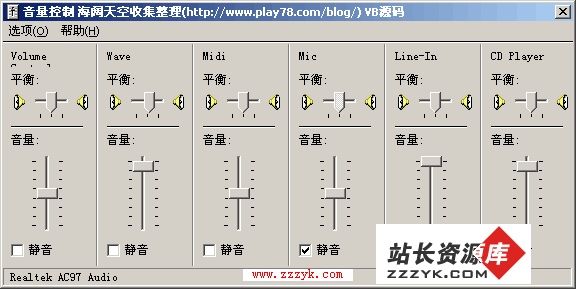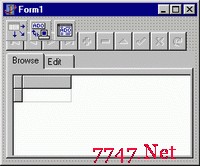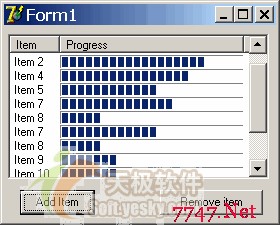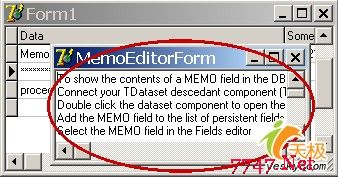通过实例看VCL组件开发全过程(二)
(接上文)
组件的代码由于假设你已经熟悉delphi开发(它和一般开发没什么不同),我们就直接贴出来并加上适当的注释:
unit Clock;
inte易做图ce
uses
SysUtils, Classes, Controls, StdCtrls,ExtCtrls;
type
TState=(StClock,StRunClock,StBackClock);//定义枚举类表示控件的3种状态:时钟、跑表、倒计时钟
TClock = class(TCustomLabel)
private
fState:TState;
fTimer:TTimer;//为什么使用这个组件作为我们组件的私有成员就不用说了吧
RCD:array[1..8] of integer;//跑表中的各个数位。
fBeginTime:string;//到计时时的开始时钟,之所以没用TTime类型是为了在后面演示属性编辑器
fWakeTime:string;//闹钟时间,出于和上面同样的理由
fAllowWake:boolean;//是否开启闹钟功能
fOnWakeUp:TNotifyEvent;//为了使组件更加完美,我们允许组件用户能够响应闹钟到来时的时件
fOnTimeUp:TNotifyEvent;//同上能够响应倒计时种完成时的事件,我们将发布这两个事件
function GetActive:boolean;//控制Timer是否工作以控制3种状态的钟是否工作
procedure SetActive(Value:boolean);
procedure SetState(Value:TState);
procedure SetBeginTime(Value:string);
procedure SetWakeTime(Value:string);
protected
procedure WalkClock(sender:TObject);//作为时钟时走种的事件
procedure RunClock(sender:TObject); //跑表
procedure BackClock(sender:TObject);//倒计时
public
constructor Create(AOwner:TComponent);override;//完成一些初始化工作
procedure ReSetRunClock; //跑表和倒计时都需要一个复位方法给组件使用者调用
procedure ReSetBackClock;
published
property State:TState read fState write SetState default StClock;//默认为时钟状态
property Active:boolean read GetActive write SetActive;//控制3种状态的钟是否工作
property BeginTime:string read fBeginTime write SetBeginTime;
property WakeTime:string read fWakeTime write SetWakeTime;
property AllowWake:boolean read fAllowWake write fAllowWake;
property OnWakeUp:TNotifyEvent read fOnWakeUp write fOnWakeUp;
property OnTimeUp:TNotifyEvent read fOnTimeUp write fOnTimeUp;
//最后我们再发布一些被TCustomLabel所隐藏而我们又需要的属性
property Align;
property Alignment;
property Color;
property Font;
property ParentColor;
property ParentFont;
property ParentShowHint;
property PopupMenu;
property ShowHint;
property Visible;
property Transparent;
property OnClick;
end;
procedure Register;
implementation
procedure Register;
begin
RegisterComponents(ClockAndTime, [TClock]);
end;
{ TClock }
constructor TClock.Create(AOwner: TComponent);
begin
inherited Create(AOwner);
//设置默认值
fTimer:=TTimer.Create(self);
//将它属于我们的组件,这样便不用编写析构函数,而可以自动在释放本组件时释放Timer
Active:=false;
AllowWake:=false;
State:=StClock;
BeginTime:=00:00:00;
WakeTime:=00:00:00;
end;
function TClock.GetActive: boolean;
begin
result:=fTimer.Enabled;
end;
procedure TClock.SetActive(Value: boolean);
begin
fTimer.Enabled:=Value;
end;
procedure TClock.SetState(Value: TState);
var
i:integer;
begin
case Value of
StClock:
begin
Active:=false;
fTimer.Interval:=1000;
fTimer.OnTimer:=WalkClock;
Active:=true;
end;
StRunClock://由于Time类型不好处理微秒操作,我们只有手工模仿这个操作,代码会稍微烦琐
begin
Active:=false;
for i:=1 to 8 do RCD[i]:=0;
Caption:=IntToStr(RCD[8])+IntToStr(RCD[7])+:+IntToStr(RCD[6])+IntToStr(RCD[5])+:+IntToStr(RCD[4]);
Caption:=Caption+IntToStr(RCD[3])+:+IntToStr(RCD[2])+IntToStr(RCD[1]);
fTimer.Interval:=10;
//经过测试,这个秒表的效果很好,然而这只是一个技术上的演示,
//实际上这么频繁(1/100秒)的不断执行RunClock会使CPU的占用一直达到100%
//这并不是一个好注意。事实上要想在跑表中显示微秒级别并做到合理的占用CPU
//这需要更加灵活和复杂的编程
fTimer.OnTimer:=RunClock;
end;
StBackClock:
begin
Active:=false;
Caption:=BeginTime;
fTimer.Interval:=1000;
fTimer.OnTimer:=BackClock;
end;
end;
fState:=Value;
end;
procedure TClock.SetBeginTime(Value: string);
begin
try
StrToTime(Value);
fBeginTime:=Value;
if State=StBackClock then
begin
Active:=false;
Caption:=Value;
end;
except
on Exception do
begin
fBeginTime:=00:00:00;
if State=StBackClock then Caption:=00:00:00;
end;
end;
end;
procedure TClock.SetWakeTime(Value: string);
begin
try
StrToTime(Value);
fWakeTime:=Value;
except
on Exception do
begin
fWakeTime:=00:00:00;
end;
end;
end;
procedure TClock.WalkClock(sender: TObject);
begin
Caption:=TimeToStr(Time);
if AllowWake and (StrToTime(Caption)=StrToTime(WakeTime)) then
begin
Beep;//蜂鸣器
if Assigned(fOnWakeUp) then
fOnWakeUp(self);
end;
end;
procedure TClock.RunClock(sender: TObject);
begin
RCD[1]:=RCD[1]+1;
if RCD[1]=10 then begin RCD[2]:=RCD[2]+1;RCD[1]:=0; end;
if RCD[2]=10 then begin RCD[3]:=RCD[3]+1;RCD[2]:=0; end;
if RCD[3]=10 then begin RCD[4]:=RCD[4]+1;RCD[3]:=0; end;
if RCD[4]=6 then begin RCD[5]:=RCD[5]+1;RCD[4]:=0; end;
if RCD[5
补充:软件开发 , Delphi ,





